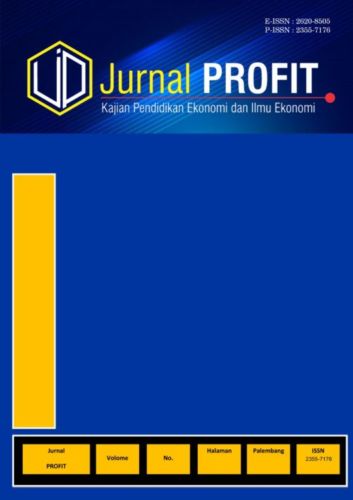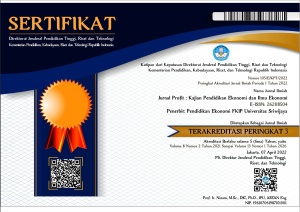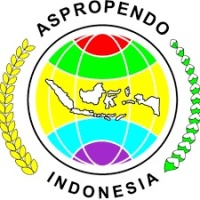TRANSISI DEMORAFI DAN EKONOMI: STUDI TENTANG PENUAAN PENDUDUK, HARAPAN HIDUP DAN PENGELUARAN
DOI:
https://doi.org/10.36706/jp.v12i1.70Keywords:
Penuaan Penduduk, Harapan Hidup, Pengeluaran Per Kapita, Pertumbuhan EkonomiAbstract
The increase in the number of elderly people creates various challenges in every aspect of life. The increase in the number of elderly people is also accompanied by a reduction in the birth rate and an increase in life expectancy in Indonesia, causing changes in the population structure. Per capita expenditure is used to see the condition of the economy. This study aims to analyze the effect of population aging, life expectancy and expenditure on economic growth in 34 Indonesian provinces from 2018 to 2023. This research is a quantitative research using panel data regression analysis method. Based on the results of the model specification test, the Fixed Effect Model is the best model used in this study. The results showed that the population aging variable had a positive but insignificant effect on economic growth in Indonesia. Meanwhile, the life expectancy variable and the per capita expenditure variable have a positive and significant effect on economic growth in Indonesia.References
Abdul Karim, Z., Nuruddin, N. A. M., Abdul Karim, B., Mohamad, M., & Ishak, I. (2023). The Impact of Population Aging and Fertility Rate on Economic Growth in Malaysia. Economic Journal of Emerging Markets, 199–211. https://doi.org/10.20885/ejem.vol15.iss2.art7
Akasumbawa, M. D. D., Adim, Abd., & Wibowo, M. G. (2021). Pengaruh Pendidikan, Angka Harapan Hidup dan Jumlah Penduduk Terhadap Pertumbuhan Ekonomi di Negara dengan Jumlah Penduduk Terbesar di Dunia. Riset, Ekonomi, Akuntansi Dan Perpajakan (Rekan), 2(1), 11–20. https://doi.org/10.30812/rekan.v2i1.1047
Azzahro, I. K., & Prakoso, J. A. (2022). Analisis Determinan Pertumbuhan Ekonomi Di Indonesia: 1991-2020. Jurnal Valuasi: Jurnal Ilmiah Ilmu Manajemen Dan Kewirausahaan, 2(1), 314–327.
Badan Pusat Statistik. (2024). statistik-penduduk-lanjut-usia-2024 (Vol. 21). https://www.bps.go.id/id/publication/2024/12/31/a00d4477490caaf0716b711d/statistik-penduduk-lanjut-usia-2024.html
Bangun, W., Calista, C., Adriana Br Ginting, A., & Simanjuntak, B. (2024). Pembangunan Sumber Daya Manusia: Upaya Meningkatkan Pembangunan Ekonomi. Syntax Literate: Jurnal Ilmiah Indonesia, 9(7). https://doi.org/10.36418/syntax-literate.v9i7
Basuki, A. T., & Prawoto, N. (2019). Analisis Regresi Dalam Penelitian Ekonomi dan Bisnis. Depok: Rajagrafindo Persada.
Chen, H. J., Huang, S. C., & Miyazaki, K. (2024). Life Expectancy, Fertility, and Retirement in an Endogenous-Growth Model With Human Capital Accumulation. Economic Modelling, 130. https://doi.org/10.1016/j.econmod.2023.106572
Hakim, L. N. (2020). Urgensi Revisi Undang-Undang Tentang Kesejahteraan Lanjut Usia. Aspirasi: Jurnal Masalah-Masalah Sosial, 11(1), 43–55. https://doi.org/10.22212/aspirasi.v11i1.1589
Haliza, F. N., & Kistanti, N. R. (2024). Indikator Indeks Pembangunan Gender Terhadap Pertumbuhan Ekonomi di Provinsi Jawa Barat. SALAM: Islamic Economics Journal, 5(2). https://doi.org/https://doi.org/10.24042/slm.v5i2.24293
Hasnawati, S., Usman, M., Elfaki, F. A. M., Faisol, A., & Russel, E. (2024). Modeling The Relationship Between Life Expectancy, Population Growth, Carbon Dioxide Emission, and GDP Growth in Indonesia. International Journal of Energy Economics and Policy, 14(4), 484–500. https://doi.org/10.32479/ijeep.16303
Kurniawati, E., & Sugiyanto, C. (2021). Pengaruh Struktur Umur Penduduk terhadap Pertumbuhan Ekonomi di Indonesia. Jurnal Ekonomi Dan Pembangunan Indonesia, 21(1), 41–58. https://doi.org/10.21002/jepi.2021.04
Lobo, C. S. S., & Falleiro, S. da P. (2024). The Implications of Population Ageing on Economic Growth: Evidence of Nonlinearity. Asian Economic and Financial Review, 14(6), 410–423. https://doi.org/10.55493/5002.v14i6.5076
Maryani, H., & Kristiana, L. (2018). PEMODELAN ANGKA HARAPAN HIDUP (AHH) LAKI-LAKI DAN PEREMPUAN DI INDONESIA TAHUN 2016. Buletin Penelitian Sistem Kesehatan, 21(2), 71–81. https://doi.org/10.22435/hsr.v21i2.245.71-81
Pan, J. N., & Chang, M. L. (2021). Population Aging, Middle-Income Trap, and Economic Growth: an Empirical Study of Asian Economies. Singapore Economic Review, 66(6), 1577–1594. https://doi.org/10.1142/S0217590818420092
Park, D., & Shin, K. (2023). Impact of Population Aging on Asia’s Future Economic Growth, 2021-2050. Asian Development Review, 40(1), 49–78. https://doi.org/10.1142/S0116110523500014
Pham, T. N., & Vo, D. H. (2021). Aging Population and Economic Growth in Developing Countries: A Quantile Regression Approach. Emerging Markets Finance and Trade, 57(1), 108–122. https://doi.org/10.1080/1540496X.2019.1698418
Sah, T., & Valeriani, D. (2024). The Effect of Aging Population, Fertility Rates, and Population Growth on Economic Growth In Indonesia. Jurnal Keluarga Berencana, 9(1). https://doi.org/10.37306/kkb.v9i1.270
Schultz, T. W. (1961). Investment in Human Capital. The American Economic Review, Vol. 15(No. 1), 1–17.
Setiawan, A. B., Yusuf, M., Yudistira, D., & Nugroho, A. D. (2023). Determining Economic Growth and Life Expectancy Linkages in Indonesia: A Simultanous Equation Model. Jurnal Pendidikan Ekonomi Dan Bisnis (JPEB), 11(01), 12–25. https://doi.org/10.21009/jpeb.011.1.2
Setiawati, S. (2020). Pengaruh Investasi, Angka Harapan Hidup, Rata-rata Lama Sekolah, Pengeluaran Perkapita dan Infrastruktur Terhadap Pertumbuhan Ekonomi. Jurnal Pendidikan Dan Ekonomi, 9(4), 1–10.
Soleman, R., Wau, T., & Lestari, A. (2023). Kontribusi Variabel Makro Ekonomi (Studi Tentang Determinan Pertumbuhan Ekonomi di Indonesia 2010-2020). In Jurnal Ekonomika dan Bisnis Islam (Vol. 6, Issue 2). https://journal.unesa.ac.id/index.php/jei
Temsumrit, N. (2023). Population Aging, Pension Systems, and Economic Growth: Applying an Overlapping Generations Model to the Informal Sector. Asian Development Review, 40(2), 305–341. https://doi.org/10.1142/S0116110523500154
Todaro, M. P., & Smith, S. C. (2003). Pembangunan Ekonomi di Dunia Ketiga Edisi Kedelapan Jilid 1. Erlangga.
Utari Swastika, S., & Arifin, Z. (2023). Pengaruh Rata-rata Lama Sekolah, Umur Harapan Hidup, dan Pengeluaran Perkapita Terhadap Pertumbuhan Ekonomi DKI Jakarta. Jurnal Ilmu Ekonomi (JIE), 7(03), 449–464.
World Economic Forum. (2017). Why do women live longer than men? https://www.weforum.org/stories/2017/03/why-do-women-live-longer-than-men/
Yang, Y., Zheng, R., & Zhao, L. (2021). Population Aging, Health Investment and Economic Growth: Based on a Cross-Country Panel Data Analysis. International Journal of Environmental Research and Public Health, 18(4), 1–16. https://doi.org/10.3390/ijerph18041801
Yusuf, M., & Setiawan, A. B. (2022). The Nexus Between Health and Economic Growth: Empirical Evidence from Indonesia. Jurnal Ekonomi Pembangunan: Kajian Masalah Ekonomi Dan Pembangunan, 23(2), 192–210. https://doi.org/10.23917/jep.v23i2.20018
Downloads
Published
How to Cite
Issue
Section
License
Copyright (c) 2025 Novriza Putri Cahyanti, Grace Natalia Marpaung

This work is licensed under a Creative Commons Attribution-ShareAlike 4.0 International License.














